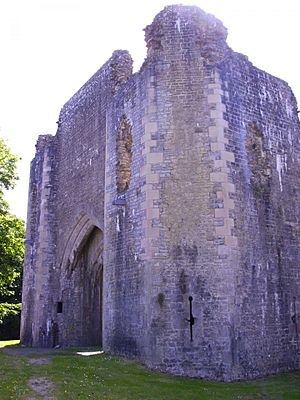St Quintins Castle facts for kids
St Quintins Castle (also known as St Quentins Castle or Llanblethian Castle, Welsh: Castell Llanfleiddan) is an old castle found in the village of Llanblethian, near Cowbridge, Wales. It's a special historical site called a scheduled monument and a Grade II listed building. Today, Cadw looks after it. The first defensive building was put up around 1102. More parts, like the gatehouse, were added around 1312. Later, it was even used as a prison. By 1741, it was already reported to be in ruins. Take a virtual tour!
Contents
Building the First Castle Defenses
Around the year 1102, a powerful Norman lord named Robert Fitzhamon gave the lands of Llanblethian to Herbert de St Quentin. It's believed that Herbert de St Quentin built the very first defenses here.
What the First Castle Looked Like
This first castle was probably a simple ringwork. Imagine a circular area with timber (wooden) walls, a raised bank, and a ditch around it for protection. Later, in the late 1100s, a rectangular stone keep was added. A keep is like a strong tower where people could live and defend themselves. You can still see parts of this old keep inside the later gatehouse. It might have replaced an earlier wooden tower.
Adding Strong Stone Walls in the 1300s
The St Quentin family owned the land until 1233. Then, a person named Richard Siward took it. But he soon lost it to Earl Richard de Clare in 1245. Richard de Clare took control of many areas in Glamorgan, from Cowbridge to Llantrisant.
Who Built the Stone Castle?
It was Richard de Clare's grandson, Earl Gilbert de Clare, who started building the stone parts of St Quintins Castle that we see today. This was likely after 1307. However, Gilbert de Clare was killed in the Battle of Bannockburn in 1314. This happened before the castle was fully finished. Many historians think the castle was never completely built. This is because there aren't many inner buildings, and the main outer wall (called a curtain wall) seems a bit weak.
How the Castle Was Designed for Defense
St Quintins Castle is a rectangular area surrounded by stone walls. It's about 64 meters (210 feet) long from east to west. The walls are quite thick, about 120 centimeters (nearly 4 feet).
Natural Protection of the Castle
The castle sits on a raised piece of land with steep slopes on most sides. This made it naturally hard for enemies to attack. The only side that wasn't as steep was the east side. To protect this weaker side, the castle had a strong gatehouse with two towers. It also had two more towers at the east entrance. The best protected side was the south, which dropped sharply down to the River Thaw. By 1741, the castle was already falling apart.
St Quintins Castle Today
Even though it's a ruin, you can still see parts of St Quintins Castle today.
What You Can See at the Ruins
You can find the base of a tower with eight sides at the southeast corner. There are also parts of a tower at the southwest corner. The most impressive part is the gatehouse, which is covered in ivy. It's a big structure where you can see the slots for two portcullises. A portcullis was a heavy, gridded gate that could be lowered quickly to block the entrance. You can also see where strong doors would have been. Most of the old keep is now just rubble. Not much is left of the outer walls (bailey walls) on the east, north, and south sides.


